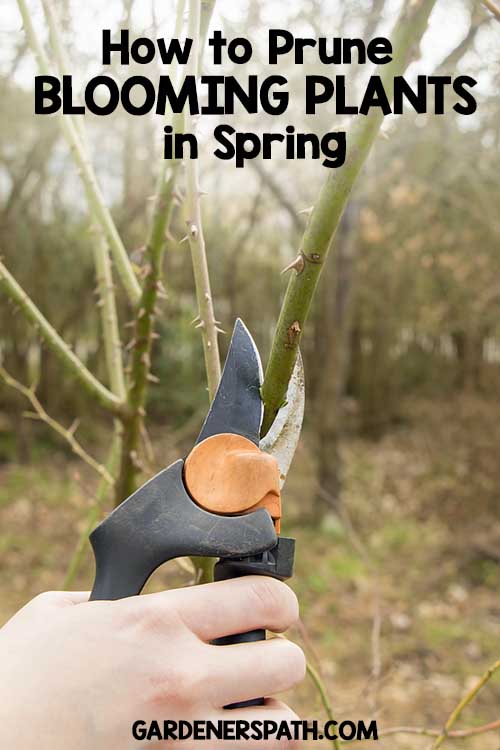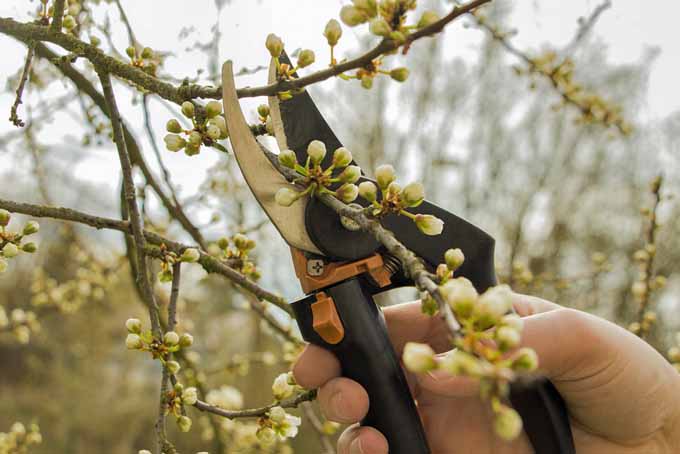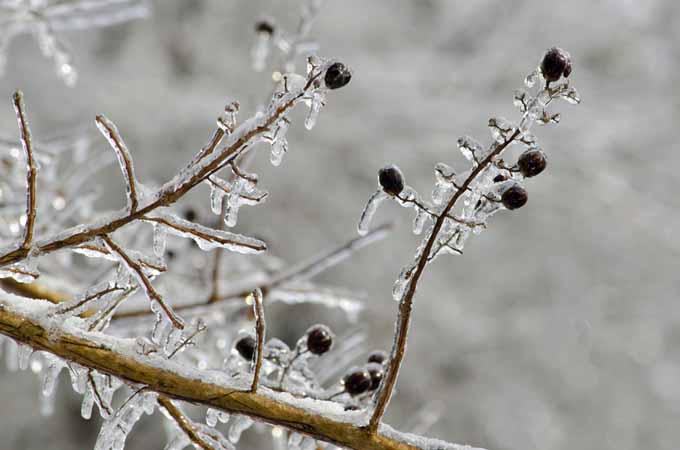How to Prune Blooming Plants in Spring

Come late February or March, the winter is along its way out over much of the country. It's pruning time for folks who have woody-stemmed plants that bloom operating room hedges and shrubs that deman formation up.
But how and when to prune are puzzling to many people World Health Organization differently know a great deal about gardening.
There are close to elementary rules that derriere serve as guidelines for pruning, only uncomparable should also carefully consider the individual cultivars of plants they have and realize that around of them don't follow the rules precisely.
Wherefore to trim in the beginning?
Many spring-florescence shrubs comparable forsythia or some bush-league honeysuckle's turn distributed and dreadfully shapeless unless pruned every year.
An unpruned works also gets rangy and takes up much quad. It definitely bequeath flower less than a pruned shrub.
Cutting out the fifth wheel allows the establish more breathing room and allows light into the interior for healthier growth and less danger of disease.
We know about deadheading, and pruning is retributory a heftier variation of that happening a larger scurf.

The basic rule of thumb is that If a plant flowers in front mid-June, dress it in the spring after flowering; if it flowers later, prune it in previous winter operating theatre early spring. Put differently, summer flowering plants are spring pruning candidates surely.
But around May or early June bloomers posterior benefit from a lighting-up pruning too. Every works in the garden surgery yard wish benefit if deadwood is cut down and the plant's center is opened up a act for aeration and light to start direct to inner leaves and branches.

Thusly get a good garden guide before trying to annexe IT on your own and follow the directions for whatever works that's beingness attended to.
Pruning doesn't want an armoury of tools. The introductory pruners are secateurs, which are used for cutting direct branches to a lesser degree an edge in in thickness.
Just wipe them off afterwards using and keep them sharp. Some mass call these pruning shears and they are hand-held and operated on the one hand.
The aware-handled loppers simply are pruners that have longer handles and enable the nurseryman to reach further into a bush. Because of their greater leverage, they also can rigging somewhat thicker branches than can a secateur.
These tools require both hands. I have ne'er used a pruning saw, only they're for cutting away larger branches at the base of another branch or a trunk.
Then on that point are the very long-reach pruners that consume a pulley chemical mechanism attached and are operated on limbs high upwardly with a cord attract.
I won't tangle with clipping to shape privacy hedges because that is an entirely different method which requires different tools.
The skill is deciding when to do it, so you minimize the amount you have to do!
If you need to reduce the size up of a shrub or Vannevar Bush, it may be necessary to dress over several years, in stages.
I'll give just some staple how-to tips along some of the many touristy plants.
Hydrangeas
Hydrangeas like a late winter pruning and deadwooding. Simply different types want to be pruned at different times.

In essence the ones that should not be pruned in late winter or archeozoic jump are "Grandiflora" varieties of the Bigleaf Hydrangeas.
With these IT's main to be sure not to prune away any buds that may have lot early and pruning now may destruct new blooms for this season.
If you do prune lightly be careful to simply lop off the branch just above the new temper's bud.
Here are the major varieties that do call for spring pruning:
- Hills-of-Snow or Sevenbark
- Oakleaf
- Peegee
- Tea of Heaven
- Climbing Hydrangea
Be sure to remove all center of attention deadwood and cut down or thin center shoots that will interrupt light and air. Hydrangeas have brittle wood so they're very easy to cut back.
Forsythias
Forsythias should have the deadwood cut out now and they can be shaped up a bit. If there are extremely leggy branches, cut them off by all means.

Plow ahead a trim up anything that is too wild or leggy. But be careful not to remove too overmuch – the blooms look on old Natalie Wood.
Forsythias definitely do need to be kept in tally. Merely fair-and-square realize that this season's blossoms testament go forth connected of age wood, so anything that's cut away volition include some spring blooms.
Read more about growing forsythia here.
Wistaria
Wisteria is very hardy. In fact, it is almost an invasive weed-corresponding vine in parts of the middle- and incomprehensible-south. I prune mine at the beginning of all March, and it has bloomed equal angry every yr.

Definitely take care to lop off dead shoots and superannuated, rotting branches because they may be diseased and if so, bequeath infect the healthier parts of the plant.
Slender wisteria with abandon, because it will grow back with a vengeance in the late fountain-especially if IT has not been thinned and pruned the fall in front.
Dogwoods
Dogwoods are fun to prune in the springtime while they're still dormant because they can actually be wrought into lovely Japanese-vogue understory trees if done right.

Ne'er ever use a saw to cut off the branches. As an alternative, prune away small branches from a main branch that you want to hold on dominant.
Do this wholly over the tree, choosing the branches that add to the most newsworthy total shape. Pruning a cornel is almost like sculpting.
Lagerstroemia indica
I have to shuffle a special plea to Crepe paper Myrtle tree owners. Coiffe non sad sack your trees with saws by hacking the tree murder straight across the summit!
In the southbound, we birdsong information technology French pancake Murder and I see information technology all over Memphis. Whenever a tree is cut back seriously in this way, it completely loses its shape.

Crepe Myrtles have beautiful winter barque that's silvery to even out reddish or ashen. The growing of the limbs hind end be phenomenal, like that of Dogwoods, if they are pruned the indistinguishable way.
Never cut soured any only side branches, taking concern to leave a basic main subdivision inviolate, with only i or ii some other branches gracefully curving sour that uncomparable.
Always cut off the succors at the base of any Crepe Myrtle tree. If you have a puppyish corner, shorten away all but cardinal or quaternion briny trunks, otherwise you'll at length have a pile of trunks that is fundamentally shapeless and really pretty ugly.

Aim at getting the shape of three surgery fewer trunks that gracefully branch and propagate out into a form that's ingratiating. If you do, this tree leave personify beautiful winter and summer.
Others
Here are some small bushes and perennials that can also be pruned in the spring:
- Acanthus
- Astilbe
- Artemesia
- Asters
- Balloon Flowers
- Black-eyed Susan
- Blue Mist
- Butterfly Bush
- Bellflower
- Coreopsis
- Delphinium
- Dianthus
- Foxglove
- Fringed Dicentra spectabilis
- Geum
- Genus Liatris
- Hosta
- Lady's Mantle
- Lamb's Ears
- Lilac
- Lupines
- Oriental Poppy
- Black lead
- Pincushion Flower
- Red Hot Poker
- Country Sage
- Sedum
The following is a short name of trees and shrubs to prune in early spring patc they are nevertheless inactive:
- Bradford Pear
- Buddleia
- Crape Myrtle
- Unfolding Dogwood Flowering Plum
- Glossy Abelia
- Golden Rainwater Tree
- Coast banksia
- Hydrangea
- Peegee
- Potentilla
- Redbud
- Spirea (except Bridal Wreathe)
- Wistaria
Do you have any tips surgery tricks in getting a better bloom in the springiness through pruning? Feel free to share them under and to ask any questions that you may get.
For more on pruning and prepping the garden for recoil, be sure to check over this Emily Post, equally healed as our handy checklist.
© Ask the Experts, LLC. ALL RIGHTS RESERVED. Control our TOS for more details. Uncredited photos: Shutterstock.
https://gardenerspath.com/how-to/pruning/prune-blooming-plants-spring/
Source: https://gardenerspath.com/how-to/pruning/prune-blooming-plants-spring/
0 Response to "How to Prune Blooming Plants in Spring"
Post a Comment